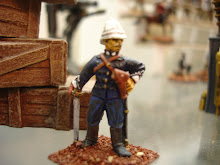Materials:
1/4" diameter hardwood dowel
1" steel washer (provides weight to help stand upright and allows for magnetized storage)
1/16" x 1/16" basswood strip
1/8 x 1/16" basswood strip
Epoxy putty (I used "Miracle Putty" - you know, the stuff Billy Mays hawks on TV)
Tools:
Craft knife (always use a nice, sharp blade - safety first!)
Cutting mat (mine is marked in inches and centimeters, with a 1/2" grid)
Glue (I used both superglue and Alene's Tacky Glue)
Step One: Cut the poles.
Very simple. Cut the 1/4" dowel into a suitable length. I did mine at about 3" (75 mm) in length, for mainly 15mm gaming. They should still work for 25mm, though a bit squat.
Step Two: Prepare the base.
Take a small lump of the epoxy putty and work the two parts together to activate it. Once activated, it will begin to set, so don't waste time here.
Apply the putty to a washer, forming a mound. Then simply press the base of your pole (which we cut in Step One) into the center of the mound to create a hole for the pole to be glued into later. Gently remove the pole so you don't mess up the hole you just made.

Step Three: Cut and assemble the crossbar and struts.
This is the part that will support the wires (which we are going to leave to the imagination for now, though I have a neat idea for adding them that I may work on later). Take a length of 1/8" x 1/16" basswood strip and cut it to 2" (5 cm).
 Then cut two pieces of 1/8" x 1/8" basswood into approximately 1" (25 mm) long, with opposing 45° miter cuts. I didn't bother with a miter box for the cuts, but used the lines on my cutting mat to help align everything.
Then cut two pieces of 1/8" x 1/8" basswood into approximately 1" (25 mm) long, with opposing 45° miter cuts. I didn't bother with a miter box for the cuts, but used the lines on my cutting mat to help align everything.
Make sure it all aligns nicely, forming an isosceles right triangle with the crossbar as the hypotenuse. Then glue the struts to the crossbar and each other.

Step Four: Attaching the crossbar to the pole.
Make a small perpendicular cut in the pole, about 3/8" from the top. Make a second small cut, parallel to the first, 1/8" further down the pole. (Sorry, the photo is blurry.)

Using a sharp craft knife, carve a shallow notch out of the pole between the two lines. The lines will act as stops for the carving and help to keep it neat.

The notch will be where you attach the center of the crossbar. It provides a nice, flat surface to improve glue adhesion. I have not been notching for the struts where they meet the pole, although you certainly could do that as well.
Put a drop of glue on the center of the crossbar and another on the point where the struts meet. Glue the crossbar into the notch and hold the struts against the pole until the glue begins to set.
Step Five: Attaching the base. [No photo]
Once you have the pole and crossbrace assembled, its time to attach the pole to the base. Check to see if the epoxy putty has set. It usually will be ready by the time you have finished all of the other steps. If not, wait a bit longer until it is good and hard.
Simply apply glue to the base end of the pole and insert it into the hole you made earlier. I put glue up the sides of the pole's base as well, to give additional strength, bonding to the bottom and sides instead of just the bottom.
Step Six: Painting. [No photo]
You have some options here. I chose option 1.
- Paint the entire pole and base. I used a dark brown spray paint.
- Leave the pole its natural color, and paint the base a nice earth tone.
- Stain the pole and paint the base afterwards.
Step Seven: Flock the base.
Once the base is dry, paint some thinned down PVA glue onto it. I use cheap throw away brushes for this. I got 150 for $3 at a craft store. Then dip into your favorite flocking blend. I used my generic "sandy/rocky" terrain blend. This makes it useful for both Mars and many places on Earth. Once that dried, I dabbed a little more thinned down PVA on and then applied some static grass (burnt grass, Woodland Scenics, IIRC).

FINAL PRODUCT
One completed telegraph/telephone pole. (Well, it still needs its shot of matte finish to protect it, but you get the idea). Singly, it looks a bit like a cross awaiting its victim (not theologically speaking, just as a rather nasty form of execution that was pretty common in the bad old days), but when placed in a line across your table, it leaves no doubt. Protecting the line is going to be a common scenario goal in the near future, I think.


1 comment:
Wow, my very first spam comment was attached to this posting.
Needless to say, it's gone now.
Kind of a right of passage, I suppose.
Post a Comment